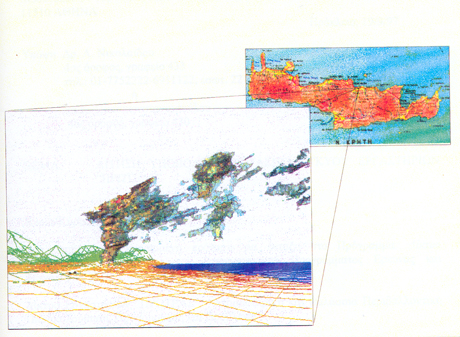In his treatise 'Of Airs, Waters and Places', Hippocrates (430 BC) pointed out that environmental conditions play a role in the pathogenesis of disease. In recent years, several studies have indicated that environmental variability is correlated with mortality and morbidity rates.
Many recent studies have concluded that ambient air pollution (photochemical or particulate matter) originating from human activity in cities (traffic, central heating, industrial processes etc) or by various natural mechanisms (Saharan dust transport, acid rain etc) has a short-term effect (with a lag of two to seven days) on morbidity and mortality rates. This is particularly evident with respect to respiratory and cardiovascular complaints and is most obvious in vulnerable sections of the population. More specifically, the dry deposition of dust can exacerbate asthma and other respiratory morbidities, while the wash-out effect from precipitation transfers the accumulated atmospheric pollutants to the earth's surface, where they are absorbed.
Apart from ambient air pollution, other factors such as abrupt weather changes and accompanying phenomena (eg emergence of cold fronts, heat waves and amplification of extreme events) contribute to the worsening of people's health. In combination with the geomorphology and topology of the region, these atmospheric anomalies have a strong influence on human discomfort.
The island of Crete is a suitable region on which to focus, since air pollution is apparent in the larger cities and the geomorphology of the island is responsible for the emergence of extreme weather conditions. The Cretan mountains are orientated perpendicularly to the southern air mass flow, generating the so-called Föhn winds. Coming down from the lee of the mountains, these dry, hot winds can have an abrupt effect on prevailing bioclimatic conditions.

IACM-FORTH has already been working on an early-warning system for a pilot study. By forecasting extreme weather events and detecting when ambient air pollution exceeds specific thresholds, the system can provide authorities with prior warning of conditions that are likely to cause or exacerbate cardiovascular and respiratory problems. Furthermore, multivariate statistical methods are applied to environmental and medical data (mainly acquired from the Cardiology Department at the University Hospital of Crete) in order to construct a model that can interpret the effects of environmental conditions on either morbidity or mortality. This system is designed to complement the existing network of meteorological stations of the Natural Disasters & Risk Assessment Facility of the Region of Crete, which can relay real-time data to an operational centre through a public broadband wireless communications network.
Please contact:
Nikolaos A. Kampanis
IACM-FORTH, Greece
E-mail: kampanis![]() iacm.forth.gr
iacm.forth.gr










